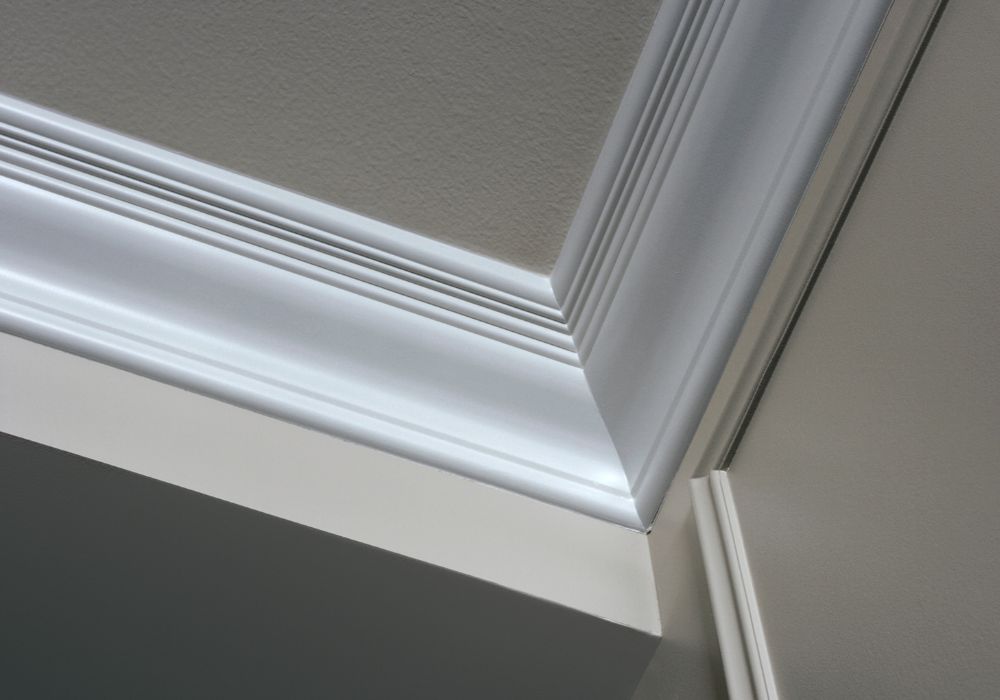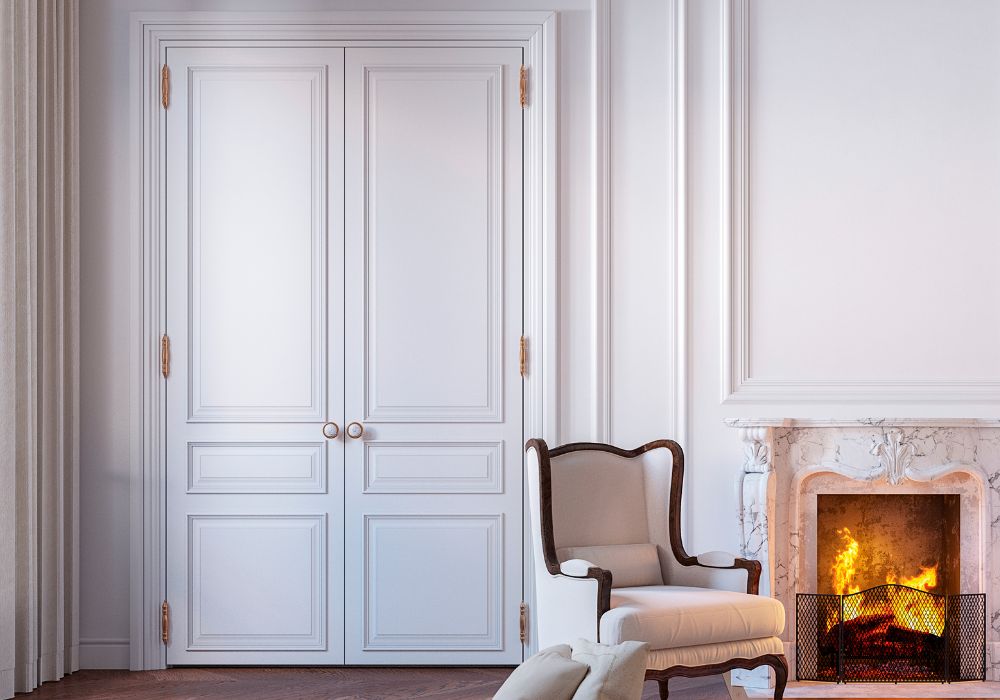The difference between Moulding, Casing, and Trim lies in the subtle yet essential details that distinguish these architectural elements, elevating the aesthetics and functionality of interior spaces.
Moulding, casing, and Trim are all integral components of interior design, serving as finishing touches that add character and refinement to a room.
Understanding their roles and applications can empower homeowners, architects, and designers to make informed decisions and create captivating living spaces that showcase beauty and craftsmanship.
What Is Moulding?

Moulding, a prominent feature in interior design, refers to decorative elements installed along the edges of walls, ceilings, doors, and windows.
This architectural adornment plays a crucial role in enhancing the overall aesthetics of a space while adding a touch of elegance and sophistication.
Let us explore the various forms, functions, and significance of moulding as the framework of a well-designed interior.
What Is the Molding Around a Door Called?
The moulding around a door is a distinctive frame surrounding the door’s opening. It is usually positioned on both sides of the door and along the top, providing a polished transition between the wall and the door itself.
Door casing comes in various styles, from simple and streamlined to intricately detailed designs, allowing homeowners to choose a look that complements their interior décor.
This casing adds a touch of elegance to the door. It conceals gaps or rough edges, creating a seamless and aesthetically pleasing finish.
What Is the Purpose Of Door Moulding?

The purpose of door moulding extends beyond mere visual appeal. One of its primary functions is to protect the edges of the door and the adjacent wall from damage, such as chipping or denting, caused by everyday use or accidental impacts.
Additionally, door moulding provides a layer of insulation, helping to seal gaps and prevent drafts, thereby contributing to energy efficiency and maintaining a comfortable indoor climate.
Beyond its practical aspects, door moulding plays a significant role in defining the architectural style of a room. Whether it’s a classic, traditional, contemporary, or ornate design, the choice of door casing can set the tone for the entire space.
It adds depth and character to an otherwise plain opening, creating a focal point that draws the eye and enhances the overall ambiance.
Door moulding is versatile in its application, as it can be paired with various types of doors, including hinged, pocket, and sliding doors.
This adaptability allows homeowners and designers to customize the look and feel of each room, tailoring the moulding design to suit the desired atmosphere and theme.
What Is Casing?
In interior design, the casing is an essential architectural component that brings a touch of finesse and completeness to various elements within a living space.
From doors and windows to baseboards and cabinets, casing plays a pivotal role in refining the overall aesthetics of a room.
We will examine why casing is not merely an optional decorative feature but an indispensable element that brings functional and aesthetic value to doors and windows.
What Is the Casing Of a Door?
The casing of a door, often referred to as door casing or door trim, encompasses the framework surrounding the door’s opening.
Unlike door moulding, which typically adorns the edges of the door and runs along the top, door casing includes the entire perimeter of the door, including both sides, the top, and sometimes the bottom.
Its primary purpose is to provide a polished transition between the door and the adjacent walls, concealing gaps or rough edges.
Door casing is available in many designs, allowing homeowners and designers to choose from various styles matching the interior decor.
From clean and minimalist profiles to intricately detailed motifs, casing presents an opportunity to add character and charm to an otherwise plain doorway.
It frames the door and elevates its presence, transforming it into a captivating focal point.
Does a Door Need a Casing?
While including casing around a door is not an absolute necessity, it undoubtedly holds numerous advantages that make it a desirable and valuable addition to any interior.
Door casing helps protect both the door and the walls from potential damage. It acts as a barrier against accidental impacts and daily wear and tear, safeguarding the edges of the door and the adjoining wall surfaces.
Beyond its protective function, the door casing contributes to the overall insulation of a room by effectively sealing the gaps between the door and the walls.
Casing aids in preventing drafts and maintaining a comfortable and energy-efficient indoor environment.
This becomes particularly significant in regions with varying climates, as casing can help retain heat during colder seasons and keep rooms cooler in warmer weather.
Door casing is integral in elevating the visual appeal of living space. It adds a finishing touch that enhances the room’s aesthetic, infusing it with refinement and elegance.
The choice of casing design can reflect the overall architectural style, whether it’s a contemporary, classic, or vintage theme.
It allows for creative expression, enabling homeowners and designers to customize each room’s atmosphere according to their preferences.
What Is Trim?
In interior design, Trim takes center stage as an indispensable embellishment that adds the perfect finishing touches to various architectural features.
From doors and windows to walls and ceilings, trim work is pivotal in elevating the overall aesthetics of living space.
With a particular emphasis on door panel trim, we will uncover its unique significance in crafting visually awe-inspiring and impeccably designed interiors.
What Is Door Panel Trim?
Door panel trim is the decorative element that adorns the face of a door. Unlike door casing, which surrounds the door’s opening, door panel trim is applied directly to the flat surface of the door itself.
It adds depth and visual interest to an otherwise plain door, making it a captivating architectural feature.
Door panel trim comes in a wide array of designs and profiles, ranging from sleek and modern to intricate and ornate, providing homeowners and designers with endless possibilities to enhance the overall ambiance of a room.
Beyond its aesthetic function, the door panel trim conceals the seams and joints between the door’s components, such as stiles, rails, and panels.
Doing so creates a seamless and polished appearance, contributing to the overall refined look of the door.
This trim work can be applied to interior and exterior doors, allowing for consistency in design throughout a home or building.
Is Door Trim Necessary?
While door trim may not be considered an absolute necessity for the basic functionality of a door, it plays a vital role in elevating the door’s overall appeal and the aesthetics of the surrounding space.
One of the primary benefits of door trim is the ability to customize and enhance the architectural style of a room.
Whether aiming for a contemporary, traditional, or vintage look, the choice of door panel trim can significantly influence the overall theme and atmosphere of the interior.
Door trim, much like casing, serves a practical purpose in protecting the edges of the door from damage.
It acts as a buffer against accidental impacts, preventing chipping, denting, and prolonging the door’s lifespan.
Additionally, door trim provides:
- An added layer of insulation.
- Sealing potential gaps between the door and its frame.
- Contributing to energy efficiency and maintaining a comfortable indoor environment.
From a design perspective, door trim offers a creative outlet for homeowners and designers to express their style and taste.
It can be tailored to match the room’s overall decor, acting as a cohesive element that ties the interior together.
With various materials, colors, and profiles, door trim allows for personalization and customization, adding a unique touch to each living space.
What Is Moulding Trim?
Moulding trim refers to the decorative elements used to enhance the appearance of moulding in interior design.
Moulding, as mentioned earlier, is the decorative architectural feature installed along the edges of walls, ceilings, doors, and windows.
Moulding trim, on the other hand, is the additional decorative layer applied on top of the moulding to add further visual interest and complexity to the overall design.
Moulding trim comes in various profiles and styles designed to complement and accentuate the underlying moulding.
It can be made from multiple materials, such as wood, MDF (Medium-Density Fiberboard), polyurethane, or plaster. The choice of material often depends on the desired look, budget, and the space’s specific requirements.
This extra layer of decoration provided by moulding Trim allows for more creativity and customization in interior design.
Homeowners and designers can use edge to create intricate patterns, add depth, or even incorporate contrasting colors to make a bold statement.
The combination of moulding and Trim can bring character and sophistication to an otherwise plain and dull surface, transforming the entire room’s aesthetic appeal.
What Is Casing Moulding?
Casing moulding, also known simply as casing, is a type of moulding that is specifically used to frame doors and windows. It is installed around the edges of the door or window openings, creating a polished transition between the opening and the adjoining wall.
Casing moulding serves both functional and decorative purposes, protecting the edges of doors and windows while adding a touch of elegance and refinement to the interior space.
Similar to other types of moulding, casing moulding comes in various designs and profiles, allowing homeowners and designers to choose styles that complement the overall interior decor.
Depending on budget, design preferences, and the project’s specific requirements, it can be crafted from different materials, such as wood, MDF, or even synthetic materials like PVC.
Casing moulding plays a significant role in defining the architectural style of a room. Whether it’s a traditional, modern, or rustic design, the choice of casing moulding can significantly influence the overall look and feel of the space.
Its installation provides a finished and cohesive appearance, concealing gaps or rough edges around the door or window frames.
What Is the Difference Between Casing And Trim?
Casing and Trim differ in their specific applications and locations within interior design. Casing, also known as door casing or door trim, is specifically used to frame doors and windows.
It surrounds the entire opening of the door or window. It provides a polished transition between the opening and the adjoining wall.
Casing serves both functional and decorative purposes, offering protection to the edges of doors and windows while enhancing the overall aesthetic appeal of the interior space.
It comes in various styles and materials to match the desired architectural theme.
On the other hand, Trim is a more general term that refers to decorative elements used to enhance the appearance of various architectural features.
It can be applied to walls, ceilings, baseboards, and other areas.
Unlike casing, Trim is not confined to framing doors and windows. Still, it can be used throughout the interior to add visual interest and sophistication.
Trim work comes in a wide range of styles and profiles, offering creative opportunities for personalization and customization in interior design.









